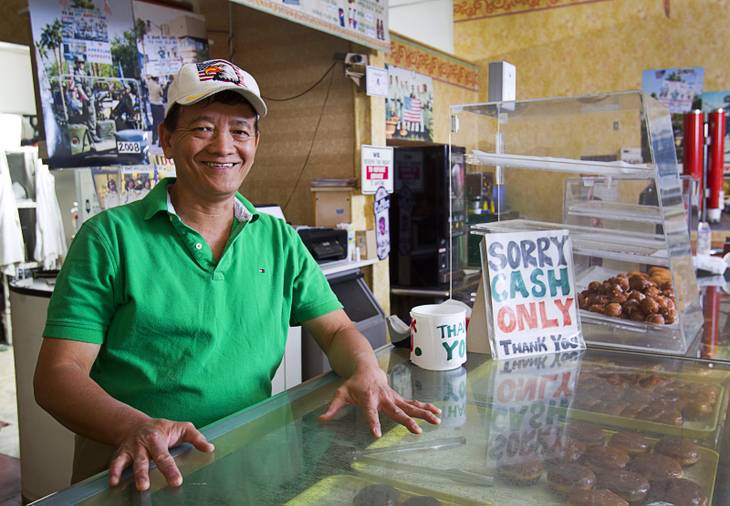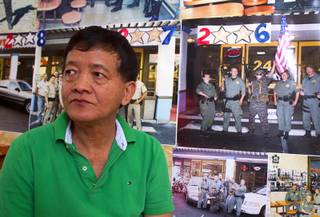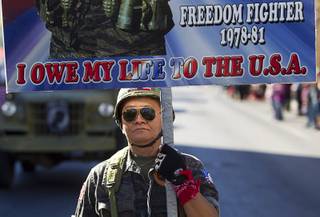
Sothy
Seang, 57, is shown at the Donut Hut, 3242 E. Desert Inn Road, on
Sunday, Nov. 24, 2013. The Donut Hut doesn’t take debit or credit cards,
and Seang is not modernizing. “People go to the ATM and get cash
because they need my doughnuts,” he said.
Sothy
Seang drives to the Donut Hut in east Las Vegas almost every night
around 7. He unlocks the door, turns on the lights, starts the fryer and
makes hundreds of doughnuts.
He doesn’t leave until after 11 a.m. the next day.
Seang
has been doing this work almost daily for the past two decades. It’s a
job few people would want – selling apple fritters, glazed
old-fashioneds and maple bars in a low-end strip mall in the middle of
the night in a bad part of town.
But to Seang, life in Las Vegas is paradise on Earth.
Before
coming to America, the Cambodian native survived the horrors of Pol
Pot, the communist dictator who killed at least 2 million people. Seang
was sent to a slave labor camp and worked 16 hours a day, barefoot, in a
rice paddy for more than three years. He slept on the ground and ate
frogs, crabs and tiny portions of rationed rice. Executions were common,
and bodies were thrown into open pits.
Seang
isn’t looking for pity, though. He’s a tough combat veteran who joined
the Cambodian Army as a teenager in the 1970s and fought Vietnamese
communists for years.
His war stories impressed Metro Police
officers who patrolled the east side and stopped by his store. Dozens of
motorcycle cops, gang-unit members and other officers have posed for
pictures with Seang at Donut Hut.
The photos blanket the walls. In them, Seang wears military fatigues and carries a rifle and an American flag .
Uniformed police line up on both sides of him, sometimes with squad
cars or motorcycles as props. In one picture, cops stand side by side,
flanking Seang and aiming their shotguns at the camera.
“If you work southeast, you know Sothy,” a veteran officer said.
Seang
arrived in the United States as a refugee with no money or job skills
and lived on welfare for years. He’s more than grateful for the help.
Today,
he is a gung-ho patriotic American citizen. He has marched in the local
Veterans Day Parade for nine years as an allied soldier, and he tells
everyone who will listen that he owes his life to the United States.
“To me, this is my heaven because my life over there was hell,” he said.
•••
Seang
was born in 1956 near Battambang in western Cambodia, a two-hour drive
from the Thailand border. He was the second of three boys. Their mom,
Sun, was a homemaker, and their dad, Sipan, worked for the local court
system.
In 1970, an already volatile Cambodia was thrust into
further chaos. Gen. Lon Nol seized power in a coup, deposing the royal
government and kicking off five years of civil war.
With war
raging in neighboring Vietnam, North Vietnamese forces used Cambodian
jungles as a staging ground to attack the South Vietnamese. American and
South Vietnamese forces invaded in mid-1970 to push them out but
failed. President Richard Nixon then ramped up America’s bombing
campaign there, strafing eastern and central Cambodia to wipe out
Vietnamese enemy fighters.
Seang’s
father joined the Cambodian Army in 1970 and became a captain. Seang
was enthralled with the military. He liked the uniforms and the fact
that people got paid to be soldiers.
He wasn’t interested in school — he usually ditched his homework to play
soccer or do other activities — so he dropped out and joined the Army
in 1972. He was 16 and was paid the equivalent of $1.60 a month.
One
night on watch, his partner was smoking a cigarette. Viet Cong soldiers
hiding in the jungle saw the burning ember. Two of them crawled arm
over arm, slit the partner’s throat and stabbed him in the chest,
killing him.
Seang was 20 feet away. He saw the cigarette drop
and heard his teenage partner moan. Seang screamed to get other
soldiers’ attention and shot the attackers with his M16, killing them.
A
Vietnamese fighter hit a nearby Cambodian machine-gun post with a
rocket-propelled grenade. He fired another at Seang but hit a Cambodian
bunker instead. Debris slammed into the back of Seang’s helmet and right
hand.
Seang reloaded his rifle and killed the attacker and
another Vietnamese soldier. Lightheaded and bleeding, Seang was
airlifted to a hospital. Doctors stitched the back of his head and
amputated his mangled index finger.
His commander, a colonel,
brought a one-star general to visit Seang in the hospital. The colonel
had informed the general about the firefight, and the general told Seang
that he wanted him as his bodyguard.
Seang stayed with him for more than a year, until Pol Pot took control.
•••
Pol
Pot, born Saloth Sar, was a French-educated communist revolutionary.
His brutal Khmer Rouge army captured the capital, Phnom Penh, in April
1975, starting a reign of terror and genocide that wiped out almost a
quarter of the country’s population.
To turn Cambodia into an
agrarian, peasant-based society, he evacuated cities and forced everyone
to work in rural, slave labor camps, where thousands of people died
from starvation and exhaustion. He emptied hospitals, shut the borders,
abolished the banking system, and banned holidays, music and
entertainment. Mass graves were filled with executed lawyers, teachers,
bureaucrats, businesspeople, Buddhist priests and soldiers from the
defeated army. Children who resisted the Khmer Rouge were buried alive,
fed to crocodiles or tossed into the air and speared on bayonets.
Seang’s
father was killed around 1976, and his family, like countless others,
was split up and sent to labor camps. With the stench of decaying bodies
in the air, Seang worked seven days a week, bathed in groundwater,
slept crowded in between rows of people and ate little food. He got a
bowl of rice and water twice a day. While working in the fields, he
stuck frogs and crabs in his pockets to cook later over a fire.
Pol
Pot’s regime collapsed after Vietnamese forces, retaliating against a
Cambodian attack, invaded the country on Christmas Day 1978.
The labor camps emptied out, but Seang had no plans to flee his country. He wanted to fight.
•••
Seang’s
Army unit had buried their weapons under a Buddhist temple in
Battambang when Pol Pot took power. When the regime fell, Seang and
other soldiers went back to collect their stockpile — M16 assault
rifles, M79 grenade launchers, machine guns, grenades and ammunition.
They wanted to take back Cambodia from the Vietnamese occupiers.
Seang
joined a resistance group, the Khmer People’s National Liberation Armed
Forces, based near the Thailand border. By mid-1981, the group had
about 7,000 fighters.
Seang spent three years in the jungle with
the group. He ate rice and canned tuna every day and slept in a tent.
They had little ammunition, so Seang stayed put and did not go on
patrol. They hoped for U.S. support, but it never came.
While
there, he met a woman who had escaped to the border with other refugees.
She came from a wealthy family, but Pol Pot’s regime had killed her
parents. Seang heard that the United States was looking for former
Cambodian soldiers, so one night in 1981, the couple, protected by armed
guards, trekked 13 miles to a United Nations refugee camp in Thailand.
They
stayed there for three months, and his wife gave birth to their first
son, Chris. The young family was bused to another refugee camp in
Thailand, where they lived for another three months, then flew to the
Philippines. They spent four months in an apartment before flying to Los
Angeles.
According to Seang, the United States paid to move them here because he fought Vietnamese communists.
•••
Seang’s
family lived in L.A. for a year, then moved to Long Beach, Calif., home
to a large Cambodian community. He was scared about finding a job
because his only real talent was jungle warfare.
He went on welfare and received food stamps while his wife attended school.
His
second son, Ronald, named for Ronald Reagan, was born in 1985. A year
later, Seang started working the graveyard shift at a 24-hour doughnut
shop. He didn’t receive a paycheck, but a Cambodian co-worker taught him
English and how to bake doughnuts.
Seang had distant relatives
in Las Vegas. They worked for casinos and told him about the good wages,
free food and health insurance. Plus, they said, it was easy work.
He
moved to Las Vegas in 1989 and was hired as a porter at Caesars Palace,
where he cleaned slot machines and the casino floor. He worked 2 a.m.
to 10 a.m.
When he was off, he would stop by a doughnut store on
Desert Inn Road near Boulder Highway. The owner was Cambodian. Seang
liked to chat with a fellow countryman, but he also was angling for
part-time work, which he got.
In 1991, Seang bought the business
for $20,000 after borrowing money from anyone who would lend it. The
store was open 24 hours a day until 2001, when Seang began closing in
the afternoon. When the shop was open around the clock, Seang worked
from 6 p.m. to 8 a.m. His wife manned the counter from 7 a.m. to 6 p.m.
The couple baked and sold doughnuts practically nonstop for two decades. They hardly saw each other and divorced in 2011.
"We worked too much like that," Seang said. “We had no life.”
•••
One
morning in 1993, around 3 a.m., three men burst into Donut Hut. Two of
them, flashing handguns, jumped over the counter, while the third took a
seat as lookout.
One of them put his gun to Seang’s head and
said that he had been watching Seang, that he knew Seang had two
children. He warned him not to fight back and to give up his money.
They
yanked the phone cord, used it to tie Seang’s hands behind his back and
put a garbage bag over his head. They took $100, put it in a pink
doughnut box and fled when a customer — a casino pit boss who always
stopped in after his shift ended at 3 a.m. — saw what was happening and
ran to call the police.
After the robbery, a customer took Seang to a gun show at Cashman Field, where he bought a pistol.
In 1997, three masked gunmen tried to rob Donut Hut. Seang fired a shot into the wall and scared them off.
When
Metro Police responded to the robberies, Seang told them his story. The
cops, many of them ex-military, took a liking to him. They started
stopping by his shop for coffee and doughnuts, to check on Seang and
scare off any would-be assailants.
If they couldn’t get back to
the station, officers went to Donut Hut at the end of their shifts to
finish reports and investigations and make phone calls.
They also
started posing, in uniform, for pictures. Seang arranged them ahead of
time and wore military paraphernalia for the camera — uniform, combat
boots, aviator sunglasses, helmet. He carried disarmed grenades and an
unloaded rifle.
About 20 of the photos cover the walls of his store.
He
also has photos of himself at Las Vegas’ Veterans Day parades. When he
marches, he wears a military uniform and holds a large sign that shows a
picture of him dressed in fatigues and armed to the teeth, with an
American flag superimposed behind him. On the sign, he calls himself a
former “Cambodian Rambo” and freedom fighter and says, “U.S.A. - All the
way! Proud to be an American.”
Seang, who became a U.S. citizen
in 1997, is almost obsessively patriotic. He talks at length about how
the American government brought him here because he fought the
communists and how the government put him on welfare to help him start a
new life.
“It’s so refreshing to be around somebody who
appreciates what the rest of us take for granted,” said Vietnam War
veteran James McGeachy, of Las Vegas, who also marches in the Veterans
Day parade. “He acquired it the hard way.”
•••
Donut Hut,
3242 E. Desert Inn Road, is squeezed between a smoke shop and a
shuttered copy store in the Desert Inn Plaza, a strip mall laced with
empty storefronts.
The shop is open six days a week from 7 p.m. to 11:15 a.m. Until a year ago, it was open seven days a week.
Seang
works there with his companion, 35-year-old Peou Sorn, a Cambodian
native whom he met a few years ago after placing a personal ad in a
Cambodian newspaper in Long Beach.
Seang likes being his own boss. Nobody controls him. The business is profitable, and he pays himself about $3,000 a month.
Still,
his life is behind the counter. He sleeps just five hours a day, and it
seems his only hobby is playing the Arizona lottery every week.
When
he talks about combat, though, he’s in his element. And he hasn’t given
up the fight. He keeps two guns at the shop for protection and wears
black Nike kneepads every day under his pants, in case he needs to drop
down and shoot an attacker through the doughnut display case.
“I’m the best,” he said. “I’m the real Rambo.”



No comments:
Post a Comment